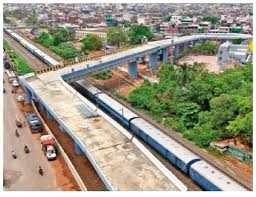The many wrong turns that led to Bhopal’s infamous right-angle bridge

In the heart of Madhya Pradesh’s capital, Bhopal, lies a bridge that has become a talking point across the country—not for its engineering brilliance, but for a puzzling design decision that has left citizens and experts scratching their heads. Known unofficially as the “right-angle bridge,” this structure near Kamla Park is a classic example of how misaligned planning, political pressures, and poor urban foresight can result in an urban infrastructure oddity.
The bridge, which was envisioned as a modern solution to the city’s growing traffic congestion, now stands as a symbol of engineering compromise and bureaucratic disconnect. How did a project meant to streamline mobility end up forcing vehicles to make an abrupt 90-degree turn mid-air?
A Bridge Born Out of Congestion Woes
Bhopal’s urban sprawl has grown rapidly over the past few decades. The increasing number of vehicles on narrow roads around areas like VIP Road, Kamla Park, and the Upper Lake made traffic congestion a daily struggle. To ease the pressure, city planners proposed a cable-stayed bridge that would cut across busy corridors and provide a quick, elevated route for commuters.
In theory, the bridge made sense—a sleek modern structure that would allow faster movement while preserving the city’s scenic beauty and historic areas. It was marketed as a step toward turning Bhopal into a “smart city.”
Politics Over Planning
But the road from planning to execution was anything but smooth. The original design suggested a straight alignment from Polytechnic Square to Kilol Park, slicing across residential and semi-protected zones. However, environmental activists and local residents objected, citing the project’s potential harm to heritage zones and green spaces. The public outcry grew louder, forcing the administration to rethink the alignment.
In the political rush to avoid delays and placate opposition groups, planners redrew the path of the bridge. What followed was a compromise that would have long-lasting consequences—a forced 90-degree turn near the middle of the bridge, bending sharply to avoid contentious land parcels.
Engineering Red Flags Ignored
From a traffic engineering perspective, a right-angle turn in an elevated corridor is far from ideal. Experts warned that such a turn would not only disrupt the flow of traffic but could also pose serious safety risks. Vehicles moving at speed would have to abruptly decelerate and maneuver the turn, increasing the risk of accidents.
Longer vehicles such as buses and trucks would face difficulty negotiating the bend, especially during peak hours. Yet, in the urgency to deliver the project on schedule and within political timelines, these warnings were brushed aside. The bridge’s structural design was modified, but its function—smooth traffic flow—was fundamentally compromised.
An Architectural Oddity in the Spotlight
Once construction was completed, the public reaction was swift and incredulous. Drone shots and videos of the bridge began circulating on social media, showcasing the now-famous right-angle turn. Netizens coined it the “bridge to nowhere” and “Bhopal’s architectural U-turn.” What was meant to be a symbol of urban progress quickly became the butt of jokes and viral memes.
Critics argue that the structure fails to address the very problem it was meant to solve—traffic congestion. Instead of offering a streamlined route, the sharp bend causes vehicles to slow down, disrupting the flow and creating bottlenecks during busy hours.
Safety, Accessibility, and Long-Term Concerns
Aside from traffic inefficiency, there are legitimate concerns about safety. There are no smart warning systems installed to alert drivers unfamiliar with the sudden turn. With limited visibility during night or rain, the chances of misjudgment are high. While some barriers have been placed to guide drivers, they are hardly enough to mitigate the risks involved.
Moreover, the bridge’s integration into the city’s road network remains incomplete. The exit and entry points don’t align well with major roads, leading to confusion and haphazard driving. Rather than being a seamless flyover, it has turned into an elevated detour.
Who Is to Blame?
As public criticism mounted, questions about accountability surfaced. Who signed off on such a design? Were alternate alignments seriously explored? Why were expert warnings ignored?
So far, no government agency or official has taken responsibility. The project was executed by the Madhya Pradesh Road Development Corporation (MPRDC), but even internal reports remain classified. Transparency has been elusive, even as the cost of the project crossed ₹40 crore.
Lessons for the Future
The right-angle bridge of Bhopal is a glaring example of what happens when political expediency trumps practical urban planning. Infrastructure decisions, especially those with lasting public impact, cannot be taken without thorough consultation with engineers, urban designers, and the communities affected.
If Bhopal—and indeed other Indian cities—are to move toward truly “smart” urban planning, lessons must be learned from this misstep. Short-term solutions driven by optics or deadlines cannot substitute for intelligent design rooted in long-term utility and safety.
A Bridge Too Bent
What remains is a structure that is functional in parts but flawed in essence. A project that had the potential to transform Bhopal’s urban mobility now stands as a cautionary tale—proof that urban infrastructure must be more than just concrete and cables. It must be rooted in logic, designed for people, and built to last—not bent into shape to fit shifting priorities.






